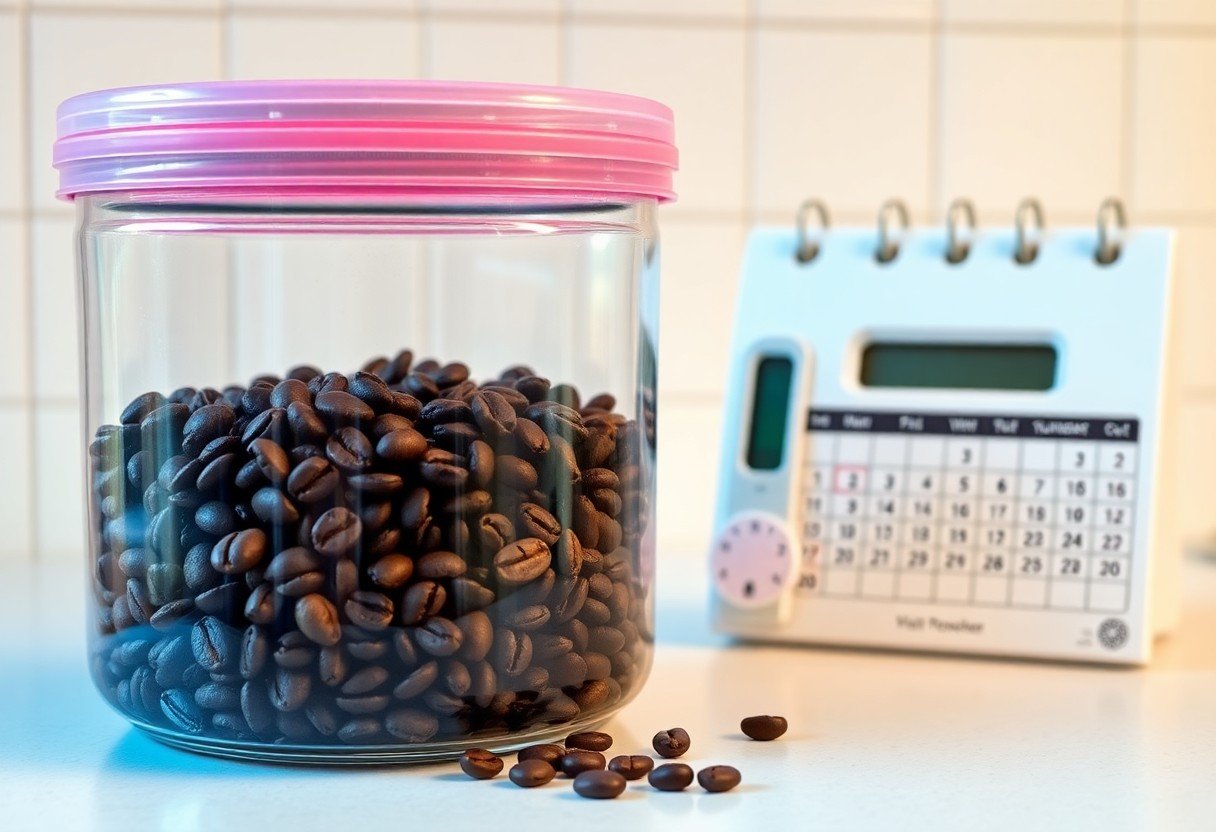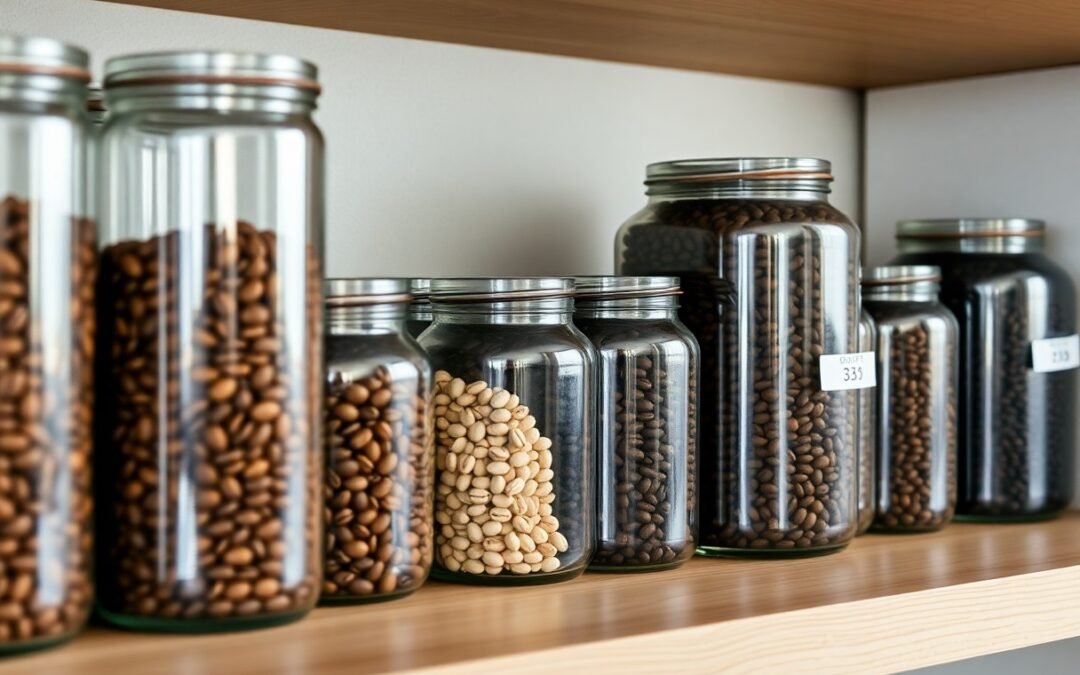It’s imperative to know how long you can store your coffee beans for optimal flavor and freshness. Proper storage techniques can significantly affect the quality of your coffee, but understanding the right time frame is key. In this post, you’ll discover the best practices for storing coffee beans and a clear timeframe to ensure you’re always brewing your best cup. Let’s examine the factors that contribute to the longevity of your coffee beans and how you can maintain their rich aroma and taste.
The Science of Coffee Bean Freshness
Understanding coffee bean freshness involves exploring the delicate chemical changes that occur over time. Freshly roasted beans contain a volatile array of compounds important for the flavor and aroma that coffee enthusiasts cherish. As time passes, these compounds begin to degrade, altering the sensory experience your cup delivers. The window for optimal freshness typically ranges from 1 to 4 weeks post-roasting, depending on storage conditions and the type of beans you choose.
Chemical Composition Changes Over Time
As coffee beans age, a range of chemical reactions takes place. The important oils, acids, and sugars within the beans start breaking down, contributing to a dulling of flavors and aromas. Oxidation is a significant factor here, leading to exposure of these volatile compounds to oxygen, which further accelerates flavor loss. If you want to experience the full spectrum of a coffee’s flavor profile, consuming freshly roasted beans is key.
Factors Affecting Flavor Profile Degradation
Several factors influence how quickly your coffee’s flavor profile deteriorates. Environmental elements such as light, heat, and humidity play a vital role in the degradation process. Beans stored in clear containers or exposed to air will lose their vibrant flavor more rapidly than those contained in opaque, airtight packages. Additionally, the type of roast and the origin of the beans can impact their longevity in terms of flavor retention.
- Exposure to light can catalyze oxidation.
- Humidity levels contribute to mold formation.
- Air exposure leads to faster flavor degradation.
- Choosing the right roast affects longevity.
- Recognizing these factors can help you maintain your coffee’s freshness longer.
Humidity, for example, can not only affect flavor but also promote mold growth, rendering your beans unsuitable for consumption. Interestingly, lighter roasts tend to retain their aromatic compounds longer than darker varieties, giving you more flexibility with storage. As you assess your storage practices, keep in mind that maintaining a steady environment can significantly help in prolonging the life of your beans.
- Store beans in airtight containers to reduce air exposure.
- Choose a cool, dark place for optimal storage.
- Avoid large quantities to ensure freshness.
- Use vacuum-sealing methods for longer preservation.
- Recognizing the impact of these factors can enhance your coffee experience dramatically.
Optimal Storage Conditions for Longevity
Understanding the optimal storage conditions for coffee beans can significantly extend their lifespan while preserving flavor and aroma. Ideal storage typically involves maintaining a consistent environment that minimizes exposure to light, air, and moisture. For your coffee beans to remain fresh, you should focus on specific parameters that promote their longevity.
Temperature and Humidity Controls
| Ideal Temperature | 60-70°F (15-21°C) |
| Ideal Humidity Level | 30-50% |
Air Exposure and Packaging Strategies
Minimizing air exposure is key to preserving the freshness of coffee beans. Use airtight containers made from opaque materials to block light and limit oxidation. Vacuum-sealed bags are also highly effective, as they remove excess air before storage. Deterioration can occur rapidly when air is introduced, so consider portioning your beans into smaller bags for occasional use.
Your coffee beans thrive in environments that limit oxidation and moisture, so packaging strategies play a pivotal role. Opt for dense, light-blocking containers that seal tightly and prevent air ingress. Vacuum-sealed bags are advantageous, as they significantly reduce the internal air content, extending freshness for months compared to standard bags. Some roasters even use one-way valves in packaging to allow gases to escape without letting air back in. This dual strategy of minimizing exposure while containing freshness will ultimately reward you with a superior cup of coffee each time you brew.
The Role of Roast Date in Coffee Quality
Your coffee’s roast date serves as a key indicator of freshness and flavor profile. Beans are best enjoyed within a few weeks of being roasted, as this is when their inherent qualities peak. After that, aromatic compounds and oils begin to dissipate, resulting in a diminished taste experience. It’s beneficial to check the roast date on the packaging, ensuring you’re consuming coffee that showcases its full potential. A fresher roast not only provides a richer flavor but can also contribute to a better brewing outcome.
Understanding the Freshness Timeline
How Roast Levels Impact Storage Life

Best Practices for Storing Coffee Beans
Optimal storage of coffee beans extends their shelf life and preserves flavor, ensuring you enjoy every brew with peak freshness. Keep your beans in a cool, dark place away from light, moisture, and heat sources. Avoid frequent openings of the storage container to minimize exposure to air, which can lead to oxidation. Aim to consume your beans within two to four weeks of the roast date for maximum flavor impact.
Container Choices for Maximum Preservation
Selecting the right container is crucial for preserving your coffee beans’ freshness. Choose an airtight, opaque container made of glass, ceramic, or BPA-free plastic. Vacuum-sealed bags are also a great option if you’re looking to minimize oxygen contact. Avoid clear containers that expose your beans to light, as well as containers that allow air in, which can contribute to staleness.
Routine Checks and Maintenance Procedures
Regularly inspecting your coffee storage setup can help ensure your beans stay fresh. Check for any signs of oxidation, such as fading color or unusual aromas. If you notice any signs of moisture, consider transferring your beans to a new container. Adjust your storage practices based on usage; if you buy larger quantities, try dividing into smaller portions. Keeping a log of your roast dates and consumption can also fine-tune your routine.
Schedule these routine checks every few weeks, especially in fluctuating climate conditions, which can affect storage. If your beans start to develop an off-putting smell or become excessively oily, it’s time to reconsider your storage method. Using a clear bag or container can help you visualize the beans’ condition while ensuring protection from light. Implementing a rotation system by placing recently opened bags at the back encourages you to consume older beans first, keeping freshness at the forefront of your coffee experience.
Common Myths vs. Realities in Coffee Storage
Dispelling misconceptions about coffee storage can significantly enhance your brewing experience. Many believe that storing beans in the freezer locks in freshness, while others think airtight containers are optional. In reality, extreme cold can cause moisture issues, and proper sealing is crucial for maintaining flavor. Understanding the truths behind these myths will equip you with the knowledge to preserve your coffee beans effectively.
Debunking Popular Storage Misconceptions
One of the most common misconceptions is that coffee should be kept in the refrigerator to extend its shelf life. This practice can expose beans to moisture and unwanted odors, ultimately compromising their flavor. Storing coffee beans in a dry, dark place, away from heat sources has proven to be a more effective method for preserving freshness.
Expert Opinions on Best Practices
Industry experts emphasize the importance of storing coffee beans in airtight containers away from light, heat, and moisture. A temperature-controlled environment with consistent conditions allows the flavors to remain intact. For optimal freshness, it’s recommended to purchase coffee in smaller quantities that you’re likely to use within a few weeks. Transparency is also key; if beans come in a one-way valve bag, it’s best to keep them in that packaging until opened.
According to coffee roasters and tasting specialists, storing beans at room temperature in opaque, airtight containers not only preserves their flavor but also prolongs their lifespan. Experts suggest that the ideal storage container material is glass or ceramic. Plastic can retain odors and is less effective against air permeability. Regularly buying smaller batches of freshly roasted beans means you can enjoy coffee at its peak freshness. Additionally, avoid overly compacting your beans, as this can lead to uneven extraction during brewing. By following these expert guidelines, you’ll ensure your coffee experiences remain delightful and flavorful.
Summing up
Now that you understand the importance of time when storing coffee beans, you should aim to consume them within two to four weeks after roasting for optimal flavor. Ensure you store your beans in an airtight container, away from light, heat, and moisture to maintain their freshness. By applying these principles, you not only extend the lifespan of your coffee but also enhance your overall coffee experience. Enjoy your perfectly brewed cup every time!
FAQ
Q: What is the ideal storage duration for coffee beans to maintain their freshness?
A: Coffee beans are best consumed within two to four weeks after roasting for optimal freshness and flavor. If stored properly, whole beans can last up to six months. However, for the best taste experience, it is advisable to purchase coffee in smaller quantities that you can consume within this time frame.
Q: What are the best practices for storing coffee beans to extend their shelf life?
A: To keep coffee beans fresh for as long as possible, store them in an airtight container in a cool, dark place. Avoid exposure to light, heat, and moisture. Ideally, use opaque containers made of materials like glass or ceramic. Avoid storing coffee beans in the fridge or freezer, as temperature fluctuations can cause condensation that affects flavor.
Q: How can I tell if my coffee beans have gone stale?
A: Stale coffee beans typically lose their vibrant aroma and may smell flat or rancid. A noticeable drop in flavor, a lack of complexity, and a dull or sour taste when brewed are also indicators of staleness. Freshly roasted beans should have a rich, aromatic scent and deliver a burst of flavors when brewed, while old beans will lack these characteristics.

